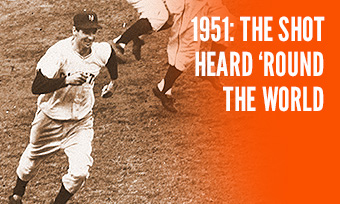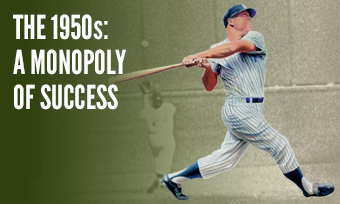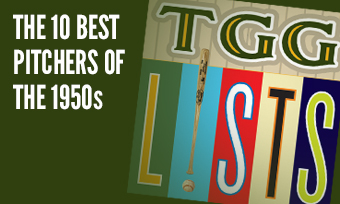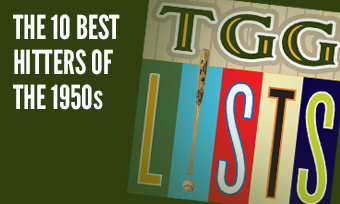The Yearly Reader
Leaders and Honors, 1951
Our list of baseball’s top 10 hitters and pitchers in both the American League and National League for the 1951 baseball season, as well as the awards and honors given to the game’s top achievers of the year.
The National League’s Top 10 Hitters, 1951
Bold type in brick red indicates league leader.
1. Stan Musial, St. Louis
Key Numbers: .355 average, 124 runs, 205 hits, 30 doubles, 12 triples, 32 home runs, 108 RBIs, 98 walks, 24 intentional walks.
The Man continued to be the class of the National League, clinching his fifth batting crown while pacing the circuit in triples for the fifth (and last) time; pitchers finally started giving him enough respect as he drew more intentional walks than anyone in the league for the first time in his career.
2. Ralph Kiner, Pittsburgh
Key Numbers: .309 average, 124 runs, 31 doubles, 6 triples, 42 home runs, 109 RBIs, 137 walks, .452 on-base percentage, .627 slugging percentage.
Kiner cranked out 40-plus homers for a fifth straight year and kept, for now, a devolving Pirates team (64-90) from losing 100.
3. Jackie Robinson, Brooklyn
Key Numbers: .338 average, 106 runs, 185 hits, 33 doubles, 7 triples, 19 home runs, 88 RBIs, 79 walks, 25 stolen bases.
Typically a fast starter, Robinson hit over .400 into the first week of June.
4. Monte Irvin, New York
Key Numbers: .312 average, 94 runs, 174 hits, 19 doubles, 11 triples, 24 home runs, 121 RBIs, 89 walks, 12 stolen bases.
Although Willie Mays arrived and Bobby Thomson stole the headlines, Irvin was the most dangerous of the Giants’ hitters for now.
5. Roy Campanella, Brooklyn
Key Numbers: .325 average, 90 runs, 164 hits, 33 doubles, 33 home runs, 108 RBIs.
Five times on the season, Campanella knocked in five runs; the Braves were the opponent in three of those games. (He would match the total in 1953.)
6. Gil Hodges, Brooklyn
Key Numbers: 158 games, .268 average, 118 runs, 25 doubles, 40 home runs, 103 RBIs, 93 walks, 99 strikeouts.
A solo home run in the second game of the NL playoff against the Giants—which counted as regular season statistics—allowed Hodges to become the first Dodger to hit 40 in one year.
7. Bobby Thomson, New York
Key Numbers: .293 average, 89 runs, 27 doubles, 8 triples, 32 home runs, 101 RBIs, 73 walks.
Thomson’s legendary home run to seal the Giants’ come-from-behind NL pennant capped a personal-best collection of round-trippers.
8. Richie Ashburn, Philadelphia
Key Numbers: .344 average, 92 runs, 221 hits, 31 doubles, 5 triples, 4 home runs, 63 RBIs, 29 stolen bases.
Reflecting the downturn in the Phillies’ lineup a year after winning the pennant, Ashburn led the NL in hits—but his teammates failed to help him get across the plate 100 times.
9. Sid Gordon, Boston
Key Numbers: .287 average, 96 runs, 28 doubles, 29 home runs, 109 RBIs, 80 walks, 28 grounded into double plays.
Gordon knocked in a run in 10 straight games, setting a franchise record; he wouldn’t get a hit in three of those contests.
10. Al Dark, New York
Key Numbers: .303 average, 114 runs, 196 runs, 41 doubles, 7 triples, 14 home runs, 69 RBIs, 12 stolen bases.
The former Rookie of the Year and future Giants manager became a crucial rock in the everyday lineup, leading New York in runs, doubles and steals.
The American League’s Top 10 Hitters, 1951
1. Ted Williams, Boston
Key Numbers: .318 average, 109 runs, 169 hits, 28 doubles, 30 home runs, 126 RBIs, 144 walks, 9 intentional walks, .464 on-base percentage, .556 slugging percentage.
The Splendid Splinter’s fourth-place finish in the AL batting race was his lowest placement since his rookie year—but there was still no player more feared within the Junior Circuit.
2. Minnie Minoso, Cleveland-Chicago
Key Numbers: .326 average, 112 runs, 173 hits, 34 doubles, 14 triples, 10 home runs, 76 RBIs, 72 walks, 16 hit-by-pitches, 31 stolen bases.
Minoso sparked the go-go in Chicago with 31 steals—12 more than what the whole team had swiped the year before.
3. Gus Zernial, Chicago-Philadelphia
Key Numbers: .268 average, 92 runs, 30 doubles, 5 triples, 33 home runs, 129 RBIs, 101 strikeouts.
Zernial gave the A’s a league-leading power boost in the franchise’s first year A.M. (After Mack), following an early trade from the White Sox. Twelve of his home runs came against the Browns, eight of which came over four games of two dingers each.
4. Eddie Joost, Philadelphia
Key Numbers: .289 average, 107 runs, 28 doubles, 5 triples, 19 home runs, 78 RBIs, 106 walks, 10 stolen bases.
Part of the “All Eddies Walk” movement of the 1950s, Joost collected over 100 walks for the fifth straight year in a streak that would last six.
5. Eddie Robinson, Chicago
Key Numbers: .282 average, 85 runs, 23 doubles, 5 triples, 29 home runs, 117 RBIs, 77 walks.
Robinson’s 29 home runs broke a White Sox season record; it would hold up until 1970.
6. Eddie Yost, Washington
Key Numbers: 154 games, .283 average, 109 runs, 161 hits, 36 doubles, 12 home runs, 65 RBIs, 126 walks, 11 hit-by-pitches.
Another ‘patient’ Eddie who gorged on walks, Yost also feasted on doubles—the only time he led the league in an extra-base hit category.
7. Larry Doby, Cleveland
Key Numbers: 134 games, .295 average, 84 runs, 27 doubles, 5 triples, 20 home runs, 69 RBIs, 101 walks.
A relatively quiet (yet still potent) campaign for Doby despite numerous nicks and knacks that finally caught up to him in September, leading him to run out of gas.
8. Vic Wertz, Detroit
Key Numbers: 138 games, .285 average, 86 runs, 27 home runs, 94 RBIs, 78 walks.
Wertz found himself carrying the Tigers’ offense more than ever, as none of his teammates hit half as many homers nor (almost) drove in half as many runs.
9. Gil McDougald, New York
Key Numbers: 131 games, .306 average, 14 home runs, 63 RBIs, 14 stolen bases.
The latest in a long line of San Franciscans making their way to the Yankees, McDougald took AL Rookie of the Year honors with all-around solid (if not spectacular) numbers.
10. Dom DiMaggio, Boston
Key Numbers: .296 average, 639 at-bats, 113 runs, 189 hits, 34 doubles, 12 home runs, 72 RBIs, 73 walks.
With Joe DiMaggio fading with age and injuries, brother Dom was suddenly playing the best baseball within the family; for the second time in three years, Dom had the majors’ longest hitting streak (27 games).
The National League’s Top 10 Pitchers, 1951
1. Robin Roberts, Philadelphia
Key Numbers: 3.30 ERA, 21 wins, 15 losses, 44 appearances, 39 starts, 22 complete games, 6 shutouts, 315 innings, 64 walks.
The Phillies may have wilted a year after taking the NL flag, but Roberts carried on strong—as he would for a number of years to come.
2. Sal Maglie, New York
Key Numbers: 2.93 ERA, 23 wins, 6 losses, .793 win percentage, 4 saves, 42 appearances, 37 starts, 22 complete games, 298 innings, 36 grounded into double plays.
In his second year back after his “suspension” for jumping to the Mexican League, Maglie emerged as a major force with his aggressive attitude for shaving back opposing hitters—thus his nickname, The Barber.
3. Larry Jansen, New York
Key Numbers: 3.04 ERA, 23 wins, 11 losses, .676 win percentage, 39 appearances, 34 starts, 278.2 innings, 56 walks.
Riding the Giants’ late-season express elevator to the top of the NL, Jansen won his last five decisions—tying Maglie for the league lead in wins by collecting his 23rd in relief thanks to Bobby Thomson’s Shot Heard ‘Round the World.
4. Warren Spahn, Boston
Key Numbers: 2.98 ERA, 22 wins, 14 losses, 39 appearances, 36 starts, 26 complete games, 7 shutouts, 310.2 innings, 109 walks, 164 strikeouts.
Spahn was never more the workhorse than in 1951, setting career highs in complete games, shutouts, innings and batters faced (1,289).
5. Chet Nichols, Boston
Key Numbers: 2.88 ERA, 11 wins, 8 losses, 33 appearances, 19 starts, 156 innings.
The 20-year-old rookie looked to be a star on the rise by copping the NL ERA title—only qualifying for the honor by throwing nine innings in his last start to reach an average of one inning per game played by the Braves—but he spent the next two years in the Army as the Korean War raged, and returned in 1954 failing to recapture the initial spark.
6. Preacher Roe, Brooklyn
Key Numbers: 3.04 ERA, 22 wins, 3 losses, .880 win percentage, 33 starts, 257.2 innings, 34 grounded into double plays.
Roe’s winning percentage is the highest ever by a National League pitcher winning 20 or more games; he was 7-0 alone against the Cardinals.
7. Don Newcombe, Brooklyn
Key Numbers: 3.28 ERA, 20 wins, 9 losses, .690 win percentage, 40 appearances, 36 starts, 272 innings, 164 strikeouts, 32 grounded into double plays.
Settled in the majors, the third-year Dodger felt spunky enough to be ejected a major league-high five times in 1951—three of them for bench jockeying.
8. Vern Bickford, Boston
Key Numbers: 3.12 ERA, 11 wins, 9 losses, 25 appearances, 20 starts, 164.2 innings.
After a 9-6 start at the All-Star Break, a shoulder injury and broken finger greatly limited Bickford’s second-half duty.
9. Murry Dickson, Pittsburgh
Key Numbers: 4.02 ERA, 20 wins, 16 losses, 45 appearances, 35 starts, 288.2 innings, 32 home runs allowed, 151 runs allowed, 101 walks.
Dickson won 20 for a lost Pittsburgh franchise that otherwise had no 10-game winners to boast.
10. Ken Raffensburger, Cincinnati
Key Numbers: 3.44 ERA, 16 wins, 17 losses, 5 saves, 42 appearances, 33 starts, 5 shutouts, 248.2 innings, 38 walks.
As with the 1944 Phillies, Raffensburger led the NL in losses despite a solid ERA. A strong September (4-0, 1.65 ERA) kept him from possibly losing 20 games for the second time.
The American League’s Top 10 Pitchers, 1951
1. Ed Lopat, New York
Key Numbers: 2.91 ERA, 21 wins, 9 losses, .700 win percentage, 31 starts, 20 complete games, 234.2 innings.
Lopat became such a thorn in the Indians’ side—he had a career 40-13 mark against them—they held “Beat Ed Lopat Night” in Cleveland. And the Indians finally did.
2. Mike Garcia, Cleveland
Key Numbers: 3.15 ERA, 20 wins, 13 losses, 6 saves, 47 appearances, 30 starts, 254 innings, 10 intentional walks.
And as if the Indians didn’t need more outstanding pitching, they got it anyway from Garcia—who won 20 for the first time.
3. Allie Reynolds, New York
Key Numbers: 3.05 ERA, 17 wins, 8 losses, .680 win percentage, 40 appearances, 26 starts, 7 shutouts, 221 innings.
Reynolds’ 32.2-consecutive scoreless inning streak, the majors’ longest in 1951, did not include his two no-hitters.
4. Early Wynn, Cleveland
Key Numbers: 3.02 ERA, 20 wins, 13 losses, 34 starts, 21 complete games, 274.1 innings, 107 walks.
Wynn won 10 games over the season’s final two months to reach 20 for the first time in his 11th year; he’d do it a few more times.
5. Vic Raschi, New York
Key Numbers: 3.27 ERA, 21 wins, 10 losses, .677 win percentage, 34 starts, 258.1 innings, 103 walks, 164 strikeouts, 13 caught stealing/picked off.
Playing with torn cartilage in his right knee all season, Raschi still managed to hit blackjack in the win column for the third straight year.
6. Mel Parnell, Boston
Key Numbers: 3.26 ERA, 18 wins, 11 losses, 36 appearances, 29 starts, 221 innings, 37 grounded into double plays.
Parnell could no longer depend on Red Sox hitters scoring a thousand runs per start for him, but he still found the winning touch as he equaled his victory total of a year earlier.
7. Saul Rogovin, Detroit-Chicago
Key Numbers: 2.78 ERA, 12 wins, 8 losses, 26 starts, 216.2 innings.
Though his limited number of starts didn’t shout ‘workhorse,’ the surprise ERA leader—placed on waivers by the Tigers in early May—pitched into extra innings five times during the year—including a 17-inning stint on July 12 that was the year’s longest.
8. Bob Feller, Cleveland
Key Numbers: 3.50 ERA, 22 wins, 8 losses, .733 win percentage, 32 starts, 249.2 innings.
Once a shoo-in as a 20-game winner, Feller reached the milestone for the first time in four years after finally working enough magic out of an arm that no longer could rely on his lightning-bolt fastball.
9. Billy Pierce, Chicago
Key Numbers: 3.03 ERA, 15 wins, 14 losses, 37 appearances, 28 starts, 240.1 innings.
Despite throwing 20 more innings than the year before, Pierce cut down on his walk totals by half—and yet still was one of six players to co-lead the AL with 14 losses, the lowest total by a league leader over a full season until 2014.
10. Ned Garver, St. Louis
Key Numbers: 3.73 ERA, 20 wins, 12 losses, 30 starts, 24 complete games, 246 innings, 31 grounded into double plays.
Garver’s 20 victories were far more impressive, since he did it for the woebegone Browns—who were 32-90 without him.









